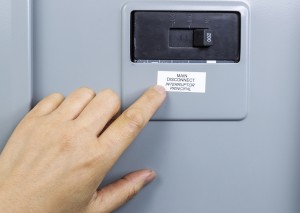An electrical panel, also known as a breaker panel, controls where electricity flows into your home from outside, determining how much power is distributed and maintained throughout. They protect you from the dangerously high levels of electricity that could be transmitted into your home. These panels house circuit breakers which protect each circuit from overloads. Using old fuse panels, panels that are too small to handle your electrical current, or obsolete circuit breakers could potentially result in harm to your home and appliances. It is important to ensure that your electrical panel is appropriate for your home. Below are some risks associated with running old electrical panels along with information on when to update them.
When Should You Inspect and Upgrade Your Electrical Panel
It is necessary to inspect the electrical panel of a newly purchased house or any panel over 25 years old. Older electrical panels, unfortunately, do not have the same safety features that accompany their newer counterparts. A few notable outdated electrical panels include Zinsco Electrical Panel, Pushmatic Electrical Panel, Federal Pacific Electric Electrical Panels, and the Fuse Box — the latter being the most widely used. Where modern appliances require 100-200 amps of power or more, the Fuse Box can only handle 30-60 amps. Generally, these outdated technologies pose a threat of fire and electrocution.
Minor shocks, blown fuses, crackling sounds from your panel boxes, dimming lights, rust on your breakers and frequently tripping breakers are all few signs that you need an electrical panel upgrade. Additionally, your electrical panel may no longer be sufficient enough to carry your electrical load if you have added new appliances into your home. Something as minor as the addition of a new fridge or as heavy as installing central air could alter the amount of amps required to sustain your home. Contact an electrician to conduct a proper assessment of your electrical panel.
Dangers of Operating an Old Electrical Panel
Zinsco Electrical Panel: The production of this unit has been discontinued entirely after the discovery of a faulty connection between the circuit breaker and the bus bar. This crucial design flaw causes the system to corrode over time. Once the breaker overheats and melts into the bus bar of the panel, it prevents the panels from tripping against dangerously high levels of electricity that could potentially be powered into the house. This is a major safety concern to a home and its occupants.
Pushmatic Electrical Panel: Overtime, this unit becomes stiff and difficult to reset. The on and off switches on this electrical panel can sometimes be fixed to one position, giving a false reading of the state of the breaker. This poses a risk of fire during an electrical overload and a short circuit.
Federal Pacific Electric Electrical Panel: Manufactured between the 1950s and the 1980s, these units have design flaws that could result in fires or electrocutions. The U.S. Consumer Product Safety Commission classified these products as safety defects that are unfit for usage.
Fuse Box: The outdated technology associated with these units result in amps that are insufficient to sustain your home, running the risks of fires and electrocution. Professional electricians and insurance companies strongly recommend that homeowners discontinue using fuse boxes.
An electrical panel is by far one of the most significant electric units in your home. It not only delivers power into the house, but also regulates electricity and protects the home’s occupants against dangerously high power surges. With a lifespan of an average of 35 years, electrical panels run the risk of becoming faulty with time. It is important to ensure that you are using the a safe, and up-to-date unit to guarantee that your household receives protection and power.


 FREE Live Music and Family Fun at Allied Gardens First Fridays The next Allied Gardens First Fridays Summer Concert in the Park is just around the corner. Grab your lawn chairs, bring a picnic, and get ready to meet your
FREE Live Music and Family Fun at Allied Gardens First Fridays The next Allied Gardens First Fridays Summer Concert in the Park is just around the corner. Grab your lawn chairs, bring a picnic, and get ready to meet your  Ideal Plumbing Heating Air Electrical Named Winner of 2023 Better Business Bureau Torch Awards for Ethics in San Diego (San Diego, CA – September 15, 2023) Better Business Bureau Serving the Pacific Southwest (BBB) has named Ideal Plumbing Heating
Ideal Plumbing Heating Air Electrical Named Winner of 2023 Better Business Bureau Torch Awards for Ethics in San Diego (San Diego, CA – September 15, 2023) Better Business Bureau Serving the Pacific Southwest (BBB) has named Ideal Plumbing Heating